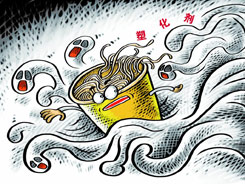Talking about the past and present life of plasticizers from various foods being contaminated
The plasticizer DEHP refers to "bis (2-ethylhexyl) phthalate", which is a toxic plastic softener for the chemical industry. It is a colorless and odorless liquid. After addition, it can make the particles more evenly distributed Therefore, it can increase the ductility, elasticity and softness. It is often used as a raw material for sofas, car seats, rubber tubes, cosmetics and toys. It is an industrial additive. On June 1, 2011, the Ministry of Health issued an emergency announcement to include the plasticizer phthalate esters in the list of non-edible substances that may be illegally added in food and easily abused food additives. As of June 1, Taiwan has detected 537 toxic foods. Several research reports show that many kinds of food such as instant noodles on the mainland have also been contaminated with plasticizers to varying degrees.

Instant noodles are also contaminated with plasticizers
What is a plasticizer
The plasticizer, Taiwanese Chinese, is the plasticizer for mainland Chinese. Plasticizer is a widely used polymer material additive in industry. Adding this substance to plastic processing can make it more flexible and easy to process. Taiwanese manufacturers use a common plasticizer DEHP instead of palm oil to formulate Toxic clouding agent can also produce thickening effect similar to emulsifier. However, people in the industry pointed out that DEHP as a plasticizer is not a raw material for food spices. Therefore, DEHP can not only be added to food, or even allowed to be used on food packaging. The plasticizer molecular structure "clouding agent" is a legal food additive. It is often used in juices, jams, beverages and other foods. It is made of gum arabic, emulsifier, palm oil and various food additives. However, because palm oil is expensive and sold at five times the price of plasticizer, Yushen Spice Company replaced it with a cheap but toxic plasticizer and added it to the "clouding agent".
The molecular structure of plasticizers is similar to hormones and is called "environmental hormones". It is a toxic chemical substance listed by the Taiwan Environmental Protection Agency. Long-term consumption may cause abnormalities of the reproductive system, and even cause the risk of teratology and cancer.
Environmental hormones refer to chemical substances secreted by external factors that interfere with the body. Traces of these compounds remaining in the environment enter the body through the food chain, forming pseudo-hormones, transmitting pseudo-chemical signals, and affecting the level of hormones in the body, thereby interfering with the original mechanism of endocrine and causing endocrine disorders.

Plasticizer molecular structure
Common plasticizer types
The plasticizers are classified into aliphatic dibasic acid esters, phthalic acid esters (including phthalic acid esters, terephthalic acid esters), benzene polyesters, benzoic acid esters, multi-components Alcohol esters, chlorinated hydrocarbons, epoxy, citric acid esters, polyesters, etc.
There are more than 100 kinds of plasticizer products, but the most commonly used is a group of compounds called phthalates.
application
Plasticizers are bulk industrial products that are widely used in various fields of the national economy, including thousands of products in plastics, rubber, adhesives, cellulose, resins, medical devices, and cables.
For example, the commonly used plastic wrap, one is PE (polyethylene) material without additives, but its viscosity is poor; the other is widely used is PVC (polyvinyl chloride) plastic wrap, which has a lot of plasticization It is used to make PVC (polyvinyl chloride) material soft and increase viscosity, which is very suitable for the packaging of fresh food.
Another product with a wide range of plasticizers is children's toys made of PVC. The European Union has specified that the content of plasticizers in plastic toys needs to be below 0.1%, but there are no clear regulations or restrictions in Taiwan. [1]
Perfume, nail polish and other cosmetics that women often use use phthalates as a deodorant to maintain the fragrance of the fragrance or make the nail polish film smoother.
Composition and properties of phthalate plasticizers
1. Phthalate Esters (PAEs) are esterified derivatives of phthalic acid (Phthalate acid) and the most common plasticizer.
2. Phthalates are widely used in daily and industrial applications, with bis (2-ethylhexyl) phthalate (DEHP) as the largest group, accounting for three-quarters of plasticizer output, followed by It is dibutyl phthalate (DBP).
3. Phthalates plasticizer is a colorless liquid with a little aromatic or odorless, medium viscosity, high stability, low volatility, low cost, low water solubility, but easily soluble in most organic solvents .
Related Links:
The molecular structure of plasticizers is similar to hormones and is called "environmental hormones". It is a toxic chemical substance listed by the Taiwan Environmental Protection Agency. Long-term consumption may cause abnormalities of the reproductive system, and even cause the risk of teratology and cancer.
Stainless Steel cups are made from high-grade 18/8 stainless steel. This material is food grade, non-toxic, durable and easy to clean.
Our Stainless Steel cups are mostly Stainless Steel Vacuum Water cups. They have a double-wall vacuum treatment, so they can ensure your drink keeps as it is. And you don't need to worry about getting your hands cold or hot.
Stainless Steel Single Wall cup has a single wall. It sacrifices thermal insulation and improves portability. Holding it in your hand all the time will not cause any discomfort.
Stainless Steel Cup,Stainless Steel Solid Color Insulated Cup,Plastic Lid With Straw Vacuum Cup,Stainless Steel Yogurt Cup
Ningbo Auland International Co.,Ltd. , https://www.everdrinkingbottle.com